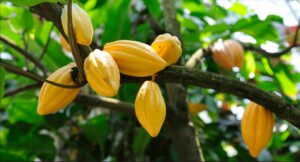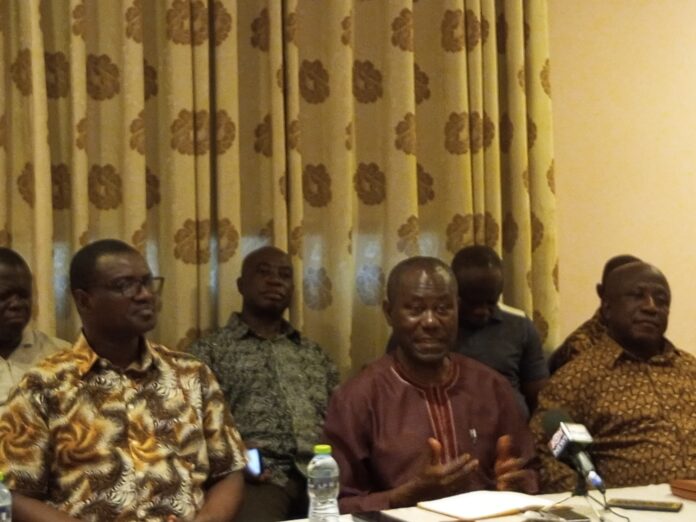The Chief Executive Officer (CEO) of the Ghana Cocoa Board (COCOBOD), Mr. Joseph Boahen Aidoo, has reiterated the need for cocoa farmers to adopt hand pollination exercises to maximise yield and boost production.
He said under the Cocoa Enhancement and Productivity Programme (CEPP), COCOBOD skilled pollinators would continue to help farmers pollinate their farms after weeding, pruning, crop protection, and fertiliser application.
Mr. Aidoo was addressing the media in Sunyani in the Bono Region after his four-day working visit to some cocoa farms in the Bono, Bono East and Ahafo regions.

Some of the towns toured included, Bechem, Duayaw Nkwanta, Goaso, Sankore, Techiman and Sunyani.
Mr. Aidoo urged the farmers to disabuse the mentality that hand pollination was expensive, adding that two and a half bags of cocoa could offset seed capital pumped into the pollination exercise.
He said COCOBOD would continue to supply chemicals and forceps to enable farmers to pollinate their own farms.
Background
Hand pollination is used to supplement natural pollination in areas where natural pollination is either irregular or deficient to increase pod development.
The Government of Ghana and Ghana Cocoa Board, as part of measures to increase productivity to over 1,000 kilogrammes per hectare, introduced hand pollination among a set of Productivity Enhancement Programmes (PEPs).
In 2017, COCOBOD launched hand pollination to kick-start a nationwide implementation of the novelty in an effort to increase yields and provide sustainable incomes for farmers.
Against the backdrop that in a natural setting, a cocoa tree produces between 20 to 50 pods, hand pollination was introduced to increase pods per tree to, at least, 200 pods.
Pruning
The COCOBOD CEO also advised the farmers to prioritise the cocoa pruning exercise implemented by the Board to increase yield.
He stressed that pruning of cocoa trees is essential in the management of a cocoa field. “When done efficiently, pruning helps to increase the tree’s productivity”, he said.
Pruning generally takes place twice a year. The first pruning takes place just after the main harvest (from April to July) and just before the rainy season, and the second pruning five months later, during the months of November and December.
The objective of pruning is to give the cocoa tree a structure that will help to maximise its production capacity.
Ideally, a cocoa tree should be maintained at a height of approximately four metres high in order facilitate management and harvesting.
Pruning is also essential for removing pods affected by diseases such as the monilla and for the removal of the witch’s broom which grows on the cocoa tree, eventually affecting the branches and the pods.
Pruning also facilitates the entrance of sunlight, which is essential for the pollination and fecundation of the flowers and the growth of the pods.
Pruning strengthens the formation of new leaves and production areas, which in turn increases the trees’ productivity levels. For each pod to grow healthily, it needs 100 healthy leaves.
Rehabilitation of cocoa farms
Mr. Aidoo said the government has started large-scale rehabilitation of cocoa farms affected by the swollen shoot disease in 2020 to reverse the declining cocoa production in the country.
According to him, most of the rehabilitated farms are currently producing high yields and assured that COCOBOD would work to sustain productivity.
“It is good that all the farms have been recovered, that is very positive. In fact we were all happy when we visited some of the farms and compared their current state to previous conditions,” he said.
Importance of visit
Mr. Aidoo said that although every quarter he is given reports from heads of departments and extension officers, it was important that he visited the farmers and engaged farmers to authenticate the reports.
Pension scheme
Mr. Aidoo said by April next year, all cocoa farmers should be on the cocoa farmer’s pension scheme. He added that COCOBOD is currently collecting farmer’s data, household information linked to farm information for the scheme.
Mr. Aidoo explained that because the scheme is voluntary, farmers are required to first enrol.
Cocoa Vs Cashew
Mr. Aidoo observed that cocoa farmers who previously converted their farms into cashew farms are now cutting down their cashew to plant cocoa.
“The new cocoa price announced at the opening of the 2023/2024 cocoa season in September 2023, coupled with the low cost of maintaining cocoa farms has boosted the interest of farmers to venture into the sector,” Mr. Aidoo said and added that “Less effort is demanded to cultivate cocoa than cashew while cocoa has ready reliable market for farmers annually than cashew”.
The COCOBOD CEO said that the country has the opportunity to gain from the $120 billion generated yearly by the industry globally if the country processes more of its cocoa into finished products.
“The country earned about $20 billion out of the $120 billion due to the export of raw cocoa beans,” he said.
Mr. Aidoo said the proportionality is not the best for the country and, therefore, urged the private sector to consider investing in the processing industry.
He appealed to cocoa farmers to avoid the use of destructive chemicals on their farms because it affects the quality of cocoa beans which impacts its attraction on the world market thereby leading to financial loss to the country.










